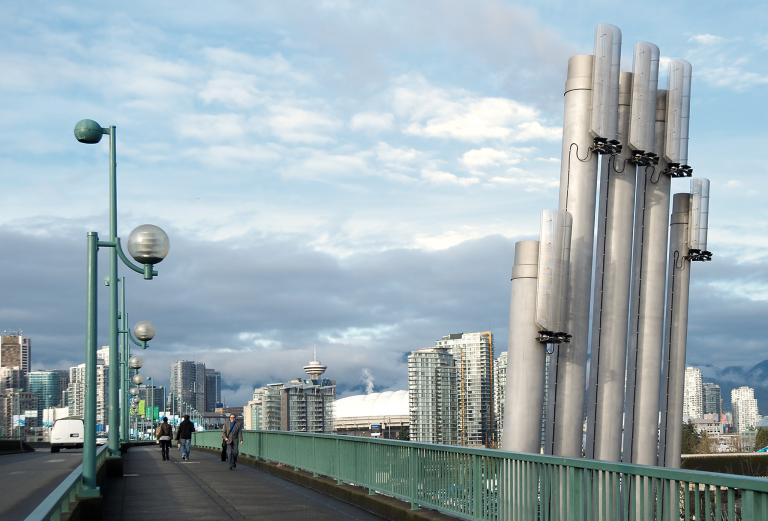Greenest City Promise Hit By Regulator Decision (UPDATED)
Originally published in Vancouver Courier on December 9, 2015. Read below for more information regarding the City of Vancouver’s bidding process (or lack thereof), and the BC Utilities Commission ruling.
Vancouver’s sizable delegation returns home this week from the Paris COP21 conference on climate policy, and they are undoubtedly pleased with the praise received for aspiring to be the world’s greenest city.
But an eyebrow raising news report revealed businesses with an interest in selling green technology paid many of the costs for the mayor and his entourage. It seems to have fazed no one at city hall though.
 Led by billionaire former New York mayor Michael Bloomberg, the corporate-funded C40 Cities Climate Leadership Group agreed to pick up costs of the Paris trip, according to a mayor’s office spokesperson.
Led by billionaire former New York mayor Michael Bloomberg, the corporate-funded C40 Cities Climate Leadership Group agreed to pick up costs of the Paris trip, according to a mayor’s office spokesperson.
It is not a coincidence, then, that bus shelter ads promoting C40 — paid for by your tax dollars, not C40 — can be seen around the city.
Now that’s what is called a “quid pro quo.”
Vancouver’s widely touted Greenest City 2020 goal is to reduce greenhouse gas emissions here by 33 per cent from a baseline set in 2007. By last count, the city had only reduced its GHGs by sever per cent, leaving another 25 per cent to go.
To pull that off from where we sit today, every household and business in Vancouver has to permanently cut his or her home heating, hot water and transportation fuel use over the next 48 months.
Twenty-five per cent is a big gap, and there is little time left to close it.
The most controversial move so far by city council to make the city greener is Vision Vancouver’s decision to approve monopoly status to a district energy utility owned by one of their most prominent financial backers.
If you do not know Ian Gillespie, owner of Westbank Projects Corporation, you will certainly know his buildings, which include structures such as the Shangri-La Tower, the Woodward’s redevelopment and the new Telus Garden among others.

According to one recent ranking, Gillespie is the most powerful individual in Vancouver today.
It could be argued that the greatest symbol of that power is his complete control of the heat and hot water supply for Vancouver’s densest neighbourhoods.
In a vote opposed only by the NPA, and without any competitive bidding process*, the City of Vancouver awarded Gillespie a monopoly “franchise” to supply district heat for the West End, Downtown, northeast False Creek, Chinatown and the Downtown Eastside.
And, to sweeten the deal, council passed bylaws making it illegal for new buildings to buy these utilities from anyone but Gillespie’s company, dubbed Creative Energy.
Similar district energy franchises are planned for the Broadway corridor — an eight-block swath roughly covering Arbutus to Main Street — and the Cambie corridor, an area that includes everything between Oak and Main streets from Broadway down to the Fraser River.
Any development over 2,000 square metres within these areas is required to connect to one of these district energy systems. Eventually the city will want all buildings connected, just as homes and places of business in Denmark and Sweden are today.
In order to attract investment and make these projects perhaps more financially stable, bylaws have been put in place to remove consumer choice.
Because of the precedent setting nature of giving monopoly control to a company where competitive options already exist, the British Columbia Utilities Commission (BCUC) was asked to give Creative Energy “CPCN” status — effectively making them the sole supplier of heat and hot water for anyone requiring a development permit.
Creative Energy sought approval for a 9.5 per cent annual return on a proposed investment estimated to be $50 to $100 million.
In a BCUC submission in response to the application, the Urban Development Institute said it would be “unfair and unreasonable” to approve a monopoly. They argue that a 9.5 per cent return is “generous” in light of their reduced risk.
In a decision that came in at the Courier’s deadline, it appears that BCUC has turned down Creative Energy’s request**. Gillespie will have the option to appeal. (read clarification below)
It is highly unlikely, however, that this will slow the city’s greenest city agenda. It just adds another hurdle for Vision Vancouver to keep its 2020 promise.
Additional reports done on the BCUC decision here by Vancouver Sun are here and here. A story was done by The Province here.
—
In response to the question of whether this was a competitive bid*
In a message from the Mayor’s office the Courier was asked to make a “correction” to this article’s claim that a competition did not take place before rewarding the monopoly franchise to Creative Energy. In fact, the City made a call for a “Request for an Expression of Interest” (RFEOI). For those without experience in such competitions, this sounds like an open bidding process.
In fact, an Expression of Interest is not a bid on the job. It is a vetting of potential contractors. No one, according to the records I have found, participated in a bidding process. The language from the City’s original RFEOI suggests that there could be an open tendering process.
The City of Vancouver (the “City”) wishes to explore whether there is interest from experienced parties (“Proponents”) to investigate, finance, design, build and operating low carbon district energy utility services (“Neighbourhood Energy”) for downtown (“Downtown”) Vancouver.
This Request for Expressions of Interest (“RFEOI”) seeks Submissions from Proponents for the implementation of Neighbourhood Energy solutions that reduce carbon emissions associated with space heating and domestic hot water use. However, projects may also incorporate building space cooling where complementary to the City’s Neighbourhood Energy objectives. Following this RFEOI, the City may issue a Request for Proposal (“RFP”) to selected Proponents but also reserves the right to enter into direct negotiations with one or more Proponents with the intent to conclude agreements for the supply of one or more types of Neighbourhood Energy solutions.
Here’s an explanation of the difference between an Expression of Interest and a Request for Proposal:
An EOI is used to shortlist potential suppliers before then seeking detailed bids from the shortlisted tenderers. An EOI is generally used when the information required from tenderers is specific but the agency is unsure of the capability of suppliers to provide the required goods and services.
A Request for Proposal, on the other hand, can be a single or a multi-staged process and is usually used when the project or requirement has been defined, but where an innovative or flexible solution is sought.
What is more interesting to those who have analyzed this reward, Creative Energy did not complete its purchase of Central Heat Distribution (CHD) until months after the City’s own deadline for the RFEOI. The company appears to have met few if any of the listed criteria in the original RFEOI by the February 2013 due date, such as demonstrating experience in financing energy systems; developing or operating low carbon district energy systems; or prior experience managing complex public consultation processes for siting energy facilities.
It is hoped that the process for rewarding these monopoly franchises are done with the most transparent and thorough processes possible.
Regarding the BCUC decision (quote from Jeff Lee story)**
The latter BCUC ruling, issued December 8, dealt a blow to Vancouver’s plan to enable the company, which is owned by developer Ian Gillespie, to make the conversion to biofuel. In its ruling, the BCUC said it doesn’t think the utility’s plan to charge new users extra fees for future construction of a low-carbon biomass facility is fair.
It also turned down a proposal in the application to build a separate hot water heat utility in Chinatown, saying it can’t judge if there is enough business.
And in an unusual rap on the city, the commission said it was concerned it was being dragged into looking like it supports the city’s neighborhood energy bylaw. That new bylaw, approved by council but not yet enacted, will make it mandatory for buildings to hook into the monopoly utility.



